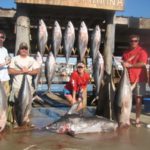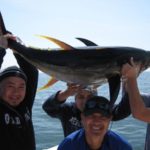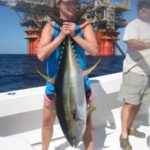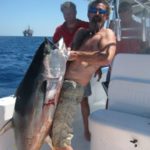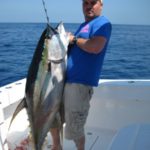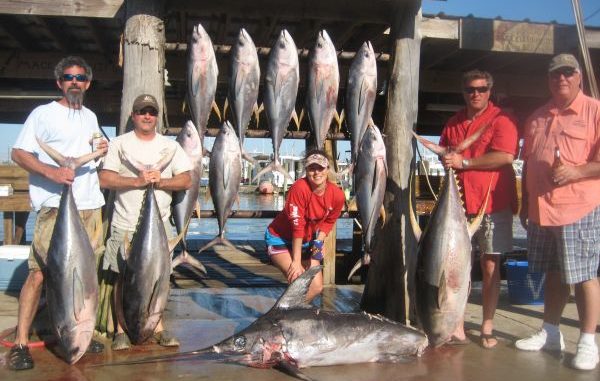
Take advantage of the weather windows this month, and share in some of the best tuna action of the year.
My transformation to a recreational angler is complete.
No longer do I subject myself to rolling waves and roaring winds all in the name of fishing. Rather than spend a day making myself miserable on the water, from my recliner I look forward to all the fish pictures in my inbox from friends whose invitations I turned down.
Rain I don’t mind so much, but wind? I would rather dance with Bobby Hebert in his dress than fish in anything over 15 m.p.h.
That’s why I was so surprised when Capt. Josh Howard with Deep South Fishing Charters (225.572.7408) told me he loves offshore fishing for yellowfin tuna this time of year.
My stomach knots up just thinking about it. Here I am watching my kids’ trampoline blowing across the backyard and getting stuck in the garden while Howard talks about fishing offshore during the spring.
“We get some rough days during March and April, so it’s not as ideal conditions as the summertime,” Howard said. “We see a lot of charter boats this time of year, but many of the recreational boats wait for the summer months just for it to be nicer — to be warm out and have calmer seas.”
In other words, March and April aren’t overlooked months for yellowfin tuna out of Venice, but the end of March and the beginning of April are definitely not as heavily fished as May, June and July.
During the early part of April, Howard says anglers headed offshore should expect to catch more fish than they would this coming summer.
“You definitely catch smaller tuna this time of year, but you catch more fish,” he said. “And the great thing about early April is that we can still fish like we did back in March and late February by fishing with live bait.”
Howard explained that small fish he called tinker mackerel start to show up in late February and they stick around until about the middle of April. He frequently sees balls of them offshore at times, with tuna busting them in open water.
Generally speaking, any of the floaters in blue water — even though Howard said the water didn’t necessarily have to be blue — hold tinker mackerel. When they are really thick, anglers can load up with bait by catching them up to six at a time on small No. 4 and 6 Sabiki rigs.
“We try to load the livewell with whatever we need for the day — 50 to 100 baits,” Howard said. “Every year is different, but by the middle of April, we lose some of the live bait.
“The tinker mackerel may be gone, but the tuna are still there. But until the bait is gone, you can still fish like you did in March.”
That means Howard is going to get on the upcurrent side of the floaters. Sometimes it’s difficult for him to tell which side is downcurrent because of wind and waves, so he simply watches for the side of the rig that’s holding bait.
It gets even simpler from there. Once he finds the bait, Howard positions his boat 100 to 400 yards off the rig and fishes the live tinker mackerel on small 5/0 or 6/0 circle hooks just kind of freelined behind him.
“The biggest thing after finding the tuna is finding out what they’re eating this time of year,” Howard said. “You want to use a live version of whatever they’re eating or at least something that simulates it. We kind of go through phases.
“Summer it’s mostly small hardtails, but in late March and early April we don’t have many hardtails. We do have the little mackerel that show up, and that’s one of the things they eat this time of year until they disappear.”
Figuring out how many miles offshore to find yellowfin tuna can sometimes be a guessing game during early April. On most days, Howard says anglers could catch them as close as 25 miles; however, the farthest he will run is about 70 miles to the edge of the Mississippi Canyon.
“And that’s just to get away from some of the pressure on the weekends if I expect more boats to be out,” Howard said. “Some days I go out 70 miles and do better than the guys fishing at 25, but some days I go out there, and the guys fishing at 25 do better than me. None of this is to say you have to be 25 miles or 70 miles; it’s just that you have to keep up with the fish and habits and what areas are holding bait.”
One step in finding good habitat is to do some preliminary internet research on sites like Hilton Navigator and Rip Charts. Howard says anglers can see where the blue water is and that getting in blue water can increase your odds.
“That’s not to say you can’t catch them in green water because we do all the time,” he sai, “but the blue water is what we’re looking for this time of year. You can see where the altimetry is best looking for low numbers. That increases your odds a little bit putting yourself in position where the conditions are most favorable.”
In that way, offshore tuna fishing is just like inshore speckled trout and redfish fishing where anglers would head out searching for the cleanest water while avoiding dirty water. Finding clean water gives you a shot. If you can find rigs holding bait in the best water, that’s where you’re going to find your yellowfin tuna.
Howard targets floating rigs that sit over 3,000 to 5,000 feet of water, so pointing out a depth of water to fish is a little misleading because they are all deep. However, even over such deep water, he’s looking to mark fish somewhere around 100 to 200 feet down.
“I keep my sounder on 200 feet when I’m fishing because if the fish are any lower than that, it’s really hard to get them to eat,” Howard said. “When fish start moving up in the water column, that’s when you know they’re getting ready to eat.
“You could be in one place and not marking any fish or you could be marking them down 400 feet. Those fish typically aren’t very responsive. But once you start marking fish later on in the day — you might see a couple fish feeding on the surface and chasing bait — there’s a good chance they’re ready to eat.”
When he’s after tuna, Howard looks for single fish away from the rigs marking on his sounder as one big red glow. Once he sees that, he knows he’s got a pretty good shot at getting one to eat.
Other than fishing live tinker mackerel, Howard sometimes catches tuna on topwater poppers if he sees fish jumping around feeding on top. Whether they’re chasing ballyhoo or tinker mackerel, if they’re busting out of the water, there’s a good chance he can get them to eat on top.
“But it’s not like if they were chasing flying fish, which makes popper fishing a little easier,” Howard said. “They’re not looking for bait that’s going to be on the surface, so you have to get the poppers really close to the fish where they are busting. It’s more of an instinct — just a reaction bite that you’re going to get on topwater. But you can be successful if you can get close enough to fish without spooking the fish and making them go down.”
Later in the month, after he starts to lose some of the tinker mackerel, Howard turns more to the topwater poppers, chunks and trolling to get them until the small hardtails start to show up in May and June. He will also be able to get a few on live pogies.
Howard suggested that trolling isn’t as big of a factor for him as it used to be. Sometimes he can troll a naked ballyhoo or ballyhoo Islander and produce a few fish here and there.
“We can also catch a few on diving baits like some of the Stretch 30s, Bombers, MirrOlures and XRaps,” he said. “Any of that stuff can produce these tuna, but, again, trolling is not a game changer. A lot of times, we pick up tuna as bycatch while trolling for wahoo.”
So if you’re not a diehard couch potato just yet, take Howard’s advice to heart and head for some yellowfin tuna out of Venice this month. Forty- to 60-pound fish with some 80- to 100-pounders could make the pain of battling Mother Nature worth the gain.
View a video of one of Capt. Josh Howard’s springtime tuna trips that he took this time last year at youtube/c41DXyt_MB0.
